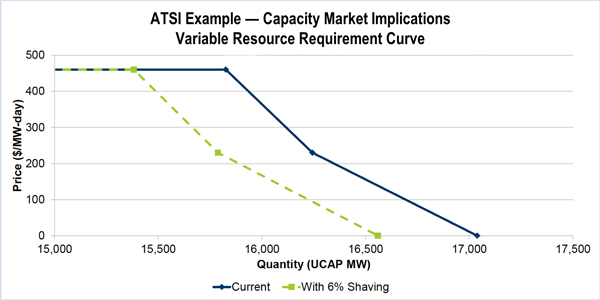By Rory D. Sweeney
PJM hopes to reduce its capacity market demand curve by including peak shaving among the variables used to develop its load forecast.
Andrew Gledhill, senior analyst of resource adequacy planning, explained the proposal at a meeting last week of the Summer Only Demand Response Senior Task Force (SODRSTF). It has the potential to reduce reliability requirements — and subsequently the variable resource requirement demand curve — by hundreds of megawatts.
PJM would start by adjusting historical loads back to 1998 through a formula that assumes perfect previous curtailment compliance. The program would be assumed to have been enacted every time a predetermined temperature-humidity index (THI) threshold was reached. THI has a strong correlation with loss-of-load expectation, the RTO said.
Each event would have been six hours from 1 to 7 p.m. on a non-holiday weekday. The events would have occurred any time between May and October, but “we don’t have a lot of high-THI events that occur in May, September and October, so … these are most likely to occur in June, July and August,” which account for the six highest load hours in the RTO, Gledhill said.
Adjusting the Model
The current method identifies the gross load for a delivery year and regresses for the forecast based on variables, including economic, weather and end-use changes.
“But there’s no variable in there for peak shaving,” Gledhill explained, so it would have been included only by reducing the gross load.
Some stakeholders voiced concerns that requiring commitments to last six hours was a high bar that would reduce offerings into capacity auctions, but others urged them to take a holistic view.
“We have to look at what PJM’s need is, not simply what the easiest program or the most customer-friendly program would be,” GT Power Group’s Dave Pratzon said.
Staff said the six-hour time frame is intentional because it mitigates peak shifting. They noted that the curtailments have already been factored into forecasts. PJM would only be looking for compliance, but these would not be RTO programs.
“The load forecast has already reflected the benefit of reduction of load when THI trigger is hit,” PJM’s Tom Falin said. “The intent of this is to improve the load forecast. … We’ve already assumed a certain amount of behavior, so it has to continue in the future, so the forecast can remain consistent.”
Impact
PJM’s analysis showed that only a percentage of the cumulative peak shaving would impact the load forecast because of the peak simply shifting to another hour. For most transmission zones, the impact shrinks as the amount of shaving increases, staff found. For example, 100% of the megawatts in a 2% shave would impact the forecast in the Penelec zone, but less than 40% of the megawatts in a 10% shave would impact the forecast in East Kentucky Power Cooperative’s zone.
It would have even less of an impact on the reliability requirement, though it would still be significant. PJM found that, given a 6% peak shave, the reliability requirement would be reduced by anywhere from 30 to 85% of the shaved megawatts.




